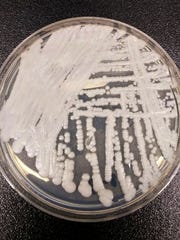Candida auris
Beware the hospitals. If you need a surgical procedure, ask if they have had patients with this disease.
https://www.chicagotribune.com/news/ct-met-candida-fungus-outbreak-illinois-20190408-story.html
and...
https://www.sciencedaily.com/releases/2010/03/100317144634.htm
The last "bad" mutation for this fungus was in 2009 when it showed up in Japan. When will it mutate again? The amount of people who were found with it on their skin is alarming.
Beware the hospitals. If you need a surgical procedure, ask if they have had patients with this disease.
Illinois health officials on Tuesday urged the public to be on guard against a rare but potentially deadly fungal disease that has sickened more than 150 people in the state, most of them in the Chicago area.
That total makes Illinois the state with the second-highest number of cases of Candida auris in the nation, behind only New York. The fungus is frequently resistant to drug treatment and is particularly dangerous to older and sick patients who have had invasive medical procedures...
...In cases where Candida auris invades the blood, heart or brain, 30 to 60 percent die, though many were afflicted by other serious illnesses. Officials did not have statistics available Tuesday on deaths in Illinois but reported that of 154 confirmed and four probable cases, 56 have blood stream infections.
The disease is difficult to identify and treat, but the Illinois Department of Public Health reports that it is becoming more common, particularly in health care settings. The vast majority of cases occur in skilled nursing facilities that care for ventilated patients, or in long-term acute care hospitals.
Candida auris has been the subject of repeated alerts from public health officials, including the U.S. Centers for Disease Control and Prevention. It has spread rapidly in the Chicago area since then, to the point where Illinois has about one-quarter of the cases nationwide.
The disease was first found in Japan in 2009 and is now in more than 20 countries. It reached Illinois by 2016.
The fungus can frequently be found on people’s skin. Screening of patients found 453 people who had the yeast on their body but were not ill. It can be spread in health care facilities through contact with contaminated people or surfaces, but healthy people don’t usually get infected, the state reported.
It more often strikes people who already have multiple underlying conditions. Patients who have had invasive medical procedures or have wounds were more commonly found to have an infection. Four out of 5 patients with Candida auris in Illinois had an intravenous infusion, two-thirds had wounds and half or more had a feeding or breathing tube or urinary catheter.
https://www.chicagotribune.com/news/ct-met-candida-fungus-outbreak-illinois-20190408-story.html
and...
Fungi have significant potential for "horizontal" gene transfer, a new study has shown, similar to the mechanisms that allow bacteria to evolve so quickly, become resistant to antibiotics and cause other serious problems.
This discovery, to be published March 18 in the journal Nature, suggests that fungi have the capacity to rapidly change the make-up of their genomes and become infectious to plants and possibly animals, including humans.
They are not nearly as confined to the more gradual processes of conventional evolution as had been believed, scientists say. And this raises issues not only for crop agriculture but also human health, because fungi are much closer on the "evolutionary tree" to humans than bacteria, and consequently fungal diseases are much more difficult to treat.
The genetic mechanisms fungi use to do this are different than those often used by bacteria, but the end result can be fairly similar. The evolution of virulence in fungal strains that was once believed to be slow has now been shown to occur quickly, and may force a renewed perspective on how fungi can behave, change and transfer infectious abilities.
"Prior to this we've believed that fungi were generally confined to vertical gene transfer or conventional inheritance, a slower type of genetic change based on the interplay of DNA mutation, recombination and the effects of selection," said Michael Freitag, an assistant professor of biochemistry and biophysics at Oregon State University.
"But in this study we found fungi able to transfer an infectious capability to a different strain in a single generation," he said. "We've probably underestimated this phenomenon, and it indicates that fungal strains may become pathogenic faster than we used to think possible."
https://www.sciencedaily.com/releases/2010/03/100317144634.htm
The last "bad" mutation for this fungus was in 2009 when it showed up in Japan. When will it mutate again? The amount of people who were found with it on their skin is alarming.


